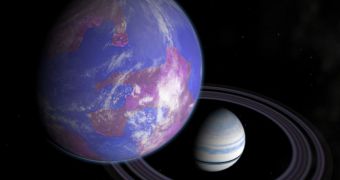In a new research, experts demonstrated that it is possible to measure the mass of an star, as long as it has at least one exoplanet with at least one exomoon orbiting it, and if the two orbiting bodies are perfectly aligned.
The new method promises to allow astrophysicists to reach an objective that has been researched in this field for many years, and namely establishing the mass of star with direct measurements.
But, regardless of the fact that the new method shows great promise, it also comes with a high degree of uncertainty attached. A very specific series of conditions need to be met in order for it to work.
At this point, using it is possible only if the targeted star has a planet around it, and that planet is orbited by a moon, and the two bodies criss-cross in front of the star as viewed from Earth.
When these conditions are met, astrophysicists can use complex mathematical formula to determine the mass of the star based solely on the sizes and orbits the two bodies orbiting it have.
“I often get asked how astronomers weigh stars. We've just added a new technique to our toolbox for that purpose,” says Harvard-Smithsonian Center for Astrophysics (CfA) expert David Kipping.
“Basically, we measure the orbits of the planet around the star and the moon around the planet. Then through Kepler's laws of motion, it's possible to calculate the mass of the star,” he adds.
But the expert concedes that the techniques used for such calculations are not simple, and that the process itself is lengthy and complicated.
“If there was no moon, this whole exercise would be impossible. No moon means we can't work out the exact density of the planet, so the whole thing grinds to a halt,” Kipping argues.
Details of the new investigation will appear in an upcoming issue of the esteemed scientific journal Monthly Notices of the Royal Astronomical Society, Space reports.
The new method is only theoretical for now, as experts have yet to discover an exoplanet with a moon around it in the correct configuration to allow for the calculations.
But the CfA is confident that the NASA Kepler planet-hunting telescope will be capable of resolving such systems in the distant Universe soon.
At this point, nearly five hundred exoplanets were discovered. If only a portion of them have exomoons in orbit, then the mass of a large number of stars could be determined directly.
This would in turn be very useful for astronomers trying to determine how stars develop, and how they exert their gravitational pull of objects surrounding them.

 14 DAY TRIAL //
14 DAY TRIAL //